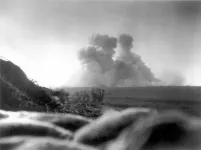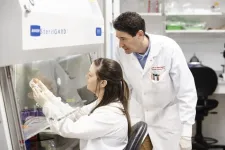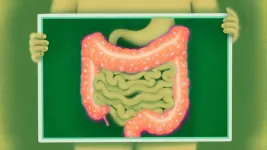The spectacular explosion of the mine at Hawthorn Ridge – a fortified German front-line position in the First World War – marked the beginning of the Battle of the Somme, and remains one of the best-known pieces of film from the whole conflict.
More than 60ft below the surface, British miners had dug a gallery for more than 900 metres from their lines and packed it with 40,000 lbs of explosives. It was one of 19 mines placed beneath German front positions that were detonated on 1st July, 1916 to mark the start of the offensive.
But the detonation of the mine at Hawthorn Ridge, famously captured by film director Geoffrey Malins, took place 10 minutes before the whistles blew at 7.30am. The early detonation, later described as a ‘colossal blunder’, alerted the Germans the infantry attack was imminent and gave them enough time to take up defensive positions in the newly-formed crater, leading to heavy losses among the attacking British troops.
Now, findings from the first ever multi-disciplinary scientific investigation of the 107-year-old crater have been published in the Journal of Conflict Archaeology. The team of researchers, scientists and historians, led by Keele University, used a range of cutting–edge technology, including drones with imaging cameras, to examine the area like never before.
Researchers discovered and excavated two sections of trenches, known as fire bays, that were used to consolidate newly-formed craters, highlighting how the Germans successfully incorporated the crater rim into their front line after the blast. They also recovered probable communication wire and distinctive German barbed wire, and found evidence of a previously unknown shallow tunnel, believed to have been dug out from the crater by German forces to provide an advanced position in No Man’s Land. They say their findings reveal new details on the history of the crater, its capture by the Germans and how they successfully incorporated it into their front line after the blast.
Dr Jamie Pringle, a forensic geoscientist at Keele University, said: “The explosion of the mine was the very first action of the Battle of the Somme, intended to give Allied forces the upper hand. We found physical evidence for the first time of how German soldiers had consolidated part of the crater left behind after the explosion, and actually used it to their advantage as a new defensive position.”
The group were given exclusive access to the site in France after the Hawthorn Ridge Crater Association took on a 99-year lease from the local authority in 2018 to protect it for future generations. The association was set up as a Franco-British organisation dedicated to the preservation and protection of the site, and carried out extensive clearance works that provided the first opportunity for detailed study.
A second mine was blown by British forces on November 13th, causing a new crater to be formed. This explosion was much more effective, aiding the 51st Highland Division to capture the ridge and nearby village of Beaumont Hamel, which had been a prominent feature of the German frontline position.
The researchers were able to pinpoint the epicentres of the two separate mine detonation locations, and identified 27 post-explosion impact shell homes, fired from British lines as they tried to dislodge the Germans. They also found an unexploded British shrapnel artillery shell with its time-fuse still intact, representative of the large number that failed to explode on the Somme, and an empty ammunition box for a Vickers Machine Gun, reflecting the period of British occupation of the site.
Dr Kris Wisniewski, a lecturer in Forensic Science at Keele University, said: “The land had been in private ownership for almost 100 years, so this scientific study, the first to be carried out on this historically important crater, was both exciting and significant. Using a range of scientific methods, we were able to map out the epicentres of both blasts and the boundaries of the subsequent craters caused by the first and second explosions, as well as post-blast defensive positions and Allied shell impact craters.
“Using drones with imaging cameras, we were able to image remotely a probable sap or shallow tunnel to the northwest of the crater, showing the German mastery of No Man’s Land after the initial detonation.”
Professor Peter Doyle, a military historian at Goldsmiths, University of London, who was part of the team, said: “The Germans had quickly mastered the art of capturing craters and used this to their advantage. Though they lost many men in the initial blast, the crater became a part of the German frontline, meaning that the chance to break through the line here was lost.
“Our study has provided new evidence of the strongpoint the Germans built from the captured crater in the middle of No Man’s Land that doomed the British attack to failure. This reinforces the idea that blowing the mine ten minutes early, to give the earth time to settle, was a very bad idea. It was only with concerted effort four months later, and a new mine, that Hawthorn Redoubt was captured by the Highlanders.”
The research team included representatives from Keele University, London South Bank University, Staffordshire University, Atlantic Technological University, Goldsmiths, University of London, Stoke-on-Trent Archaeology Service and Cotswold Archaeology.
END
First ever scientific study on First World War crater reveals new details on its history
2024-01-08
(Press-News.org)
ELSE PRESS RELEASES FROM THIS DATE:
Blood flow changes in the eyes could influence visual symptoms of migraines
2024-01-06
A recent study found changes in blood flow in the retina could explain why some migraine patients experience visual symptoms. The findings could represent a long-sought observable marker for migraines that doctors can use to aid in the clinical treatment of the condition.
While patients with migraines often experience symptoms such as pain around the eye, sensitivity to light, blind spots and visual blurring, the mechanisms behind those symptoms have not been well understood. UCLA Health researchers used a non-invasive imaging technique, known as optical coherence tomography angiography, or OCTA, ...
Global scientific network highlights plant genera named for women
2024-01-06
A network of scientists across the globe have identified more than 700 plant genera named for women. This is a nearly twenty-fold increase in the number of genera linked to women before the group started working on the list.
The project, which aimed to highlight the contribution of women to botany, was the result of social media conversations about plants named for people.
What began as a simple question about how many and which plant genera were named for women evolved into a global network of scientists who built ...
UofL researchers are unmasking an old foe’s tricks to thwart new diseases
2024-01-05
When the body encounters bacteria, viruses or harmful substances, its innate immune cells, neutrophils, assemble at the site to combat the invader.
Bacteria and viruses have ways to avoid these defenses, however. Yersinia pestis, the bacteria that causes bubonic and pneumonic plague, for example, can hide from the immune system, allowing it to replicate in the body unhindered until it can overwhelm the host. This ability allowed Y. pestis to spread bubonic plague across Europe in the 14th Century, killing a third of the European population.
While plague may not be a serious threat to human health in modern times, researchers at the University of Louisville are studying Y. ...
Soil fungi may help explain the global gradient in forest diversity
2024-01-05
A paper published in Nature Communications Biology contributes to the growing appreciation for the outsize role that microbes play in everything from human digestion to crop yields: Microbes in the soil—fungi in this case—appear to be influencing forest diversity on a global scale.
Forests on Earth exhibit a marked gradient from the equator toward the poles: Tropical forests near the equator tend to include a large number of different species, whereas forests nearer the poles support less plant diversity.
One explanation for this phenomenon maintains that soil pathogens, including bacteria and fungi, help create this gradient. ...
UC Davis Health creates road map to diversify health care workforce
2024-01-05
How can health care systems increase diversity and inclusion in their workforce?
UC Davis Health, recognized by Forbes as a "Best Employer in California", has developed a road map for increasing workforce diversity across the industry. While California banned the consideration of race or ethnicity in hiring at public institutions in 1996, UC Davis Health has since come up with a holistic outreach and local recruitment plan that has proven effective. And that approach is now receiving global attention through a new case study published in New England Journal ...
PTSD, depression, and anxiety nearly doubles in Israel in aftermath of Hamas attack
2024-01-05
A study conducted by researchers at Ruppin Academic Center in Israel and Columbia University documents the broad impact on the mental health of Israelis, both Jews and Arabs, with sharp increases in post-traumatic stress disorder (PTSD), depression, and anxiety in the aftermath Hamas' attack in October.
The study, published in the Lancet’s EClinicalMedicine Jan. 5, 2023, found the prevalence of probable PTSD, depression, and anxiety in the weeks following the attacks (29% for PTSD, ...
When bad cells go good: Harnessing cellular cannibalism for cancer treatment
2024-01-05
(Santa Barbara, Calif.) — Scientists have solved a cellular murder mystery nearly 25 years after the case went cold. Following a trail of evidence from fruit flies to mice to humans revealed that cannibalistic cells likely cause a rare human immunodeficiency. Now the discovery shows promise for enhancing an up-and-coming cancer treatment.
“This paper takes us from very fundamental cell biology in a fly, to explaining a human disease and harnessing that knowledge for a cancer therapy,” ...
Researchers identify why cancer immunotherapy can cause colitis
2024-01-05
Researchers at the University of Michigan Health Rogel Cancer Center have identified a mechanism that causes severe gastrointestinal problems with immune-based cancer treatment.
They also found a way to deliver immunotherapy’s cancer-killing impact without the unwelcome side effect.
The findings are published in Science.
“This is a good example of how understanding a mechanism helps you to develop an alternative therapy that’s more beneficial. Once we identified the mechanism causing the colitis, we could then develop ways to overcome this problem and prevent colitis while preserving the anti-tumor effect,” said senior ...
JNM publishes procedure standard/practice guideline for FES PET imaging of breast cancer
2024-01-05
Reston, VA — The Society of Nuclear Medicine and Molecular Imaging (SNMMI) and the European Association of Nuclear Medicine (EANM) have issued a new procedure standard/practice guideline for estrogen receptor imaging of breast cancer patients using FES PET. The standard/guideline, published ahead of print in The Journal of Nuclear Medicine, is intended to assist physicians in recommending, performing, interpreting, and reporting the results of 18F-FES PET studies for patients with breast cancer.
More than two million women worldwide are diagnosed with breast cancer ...
Can we fight back against Parkinson’s disease? These research volunteers hope so
2024-01-05
About three years before he retired, David Campbell noticed something weird happening as he typed. Whenever he tried to hit a letter, say “a,” he’d get “aaa,” like the keyboard was jamming or his finger was triple-tapping the key. That wasn’t the only thing that seemed off—his sense of smell was faltering. “Little things,” he says, “that I didn’t think of as being a big deal.”
A couple of weeks after he retired in fall 2020, Campbell learned the little things weren’t ...



